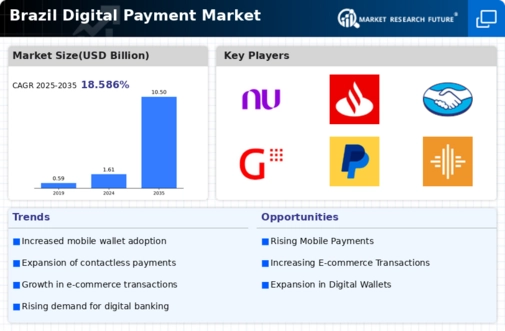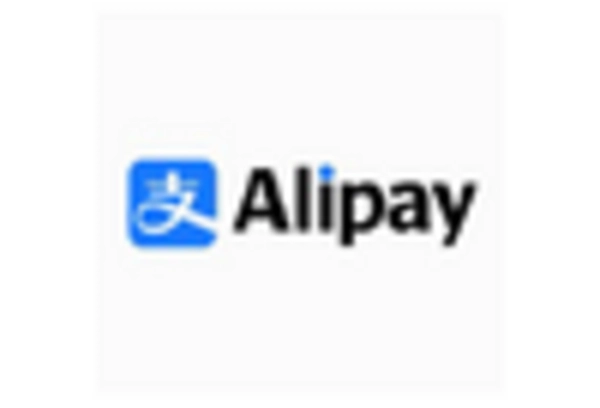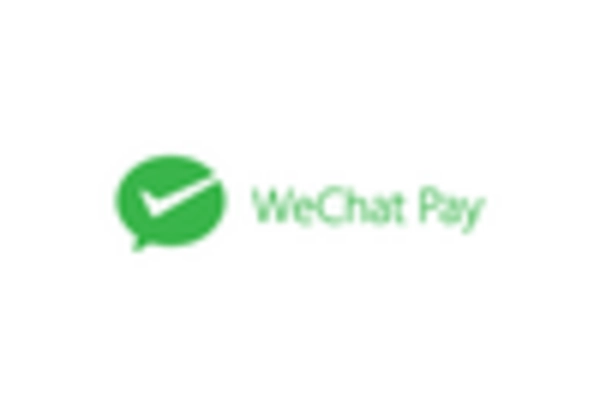Growing E-commerce Sector
The burgeoning e-commerce sector in Brazil significantly influences the digital payment market. With online retail sales projected to reach $30 billion by the end of 2025, the demand for efficient and secure payment methods is escalating. Consumers increasingly prefer digital payment options for their online purchases, leading to a shift in payment preferences. In 2025, it is anticipated that over 50% of e-commerce transactions will be conducted through digital payment platforms. This trend is further supported by the rise of social commerce, where social media platforms facilitate direct purchases. As a result, the digital payment market is poised for growth, driven by the evolving shopping habits of Brazilian consumers.
Rise of Fintech Companies
The emergence of fintech companies is transforming the digital payment market in Brazil. These innovative firms are leveraging technology to offer tailored financial solutions, including payment processing, peer-to-peer transfers, and digital wallets. As of November 2025, Brazil hosts over 800 fintech startups, many of which focus on enhancing the payment experience. This competitive landscape encourages traditional banks to innovate and improve their services, leading to a more dynamic market. The digital payment market is likely to see increased collaboration between fintechs and established financial institutions, fostering a more inclusive ecosystem. This trend may result in a broader range of payment options for consumers and businesses alike.
Government Initiatives and Regulations
Government initiatives play a pivotal role in shaping the digital payment market in Brazil. The Central Bank of Brazil has implemented regulations aimed at promoting financial inclusion and enhancing the efficiency of payment systems. The introduction of the Instant Payment System (PIX) has revolutionized the way transactions are conducted, allowing for real-time payments 24/7. As of November 2025, over 70 million Brazilians are actively using PIX, indicating its widespread acceptance. These regulatory frameworks not only foster competition among payment service providers but also ensure consumer protection. Consequently, the digital payment market is likely to expand as more individuals and businesses adopt these innovative solutions.
Increased Consumer Awareness and Adoption
Consumer awareness regarding the benefits of digital payments is on the rise in Brazil. As individuals become more educated about the convenience, speed, and security of digital transactions, adoption rates are increasing. Surveys indicate that approximately 65% of Brazilians prefer digital payment methods over traditional cash transactions. This shift is particularly evident among younger demographics, who are more inclined to embrace technology. The digital payment market is likely to benefit from this growing acceptance, as businesses adapt to meet consumer preferences. Additionally, educational campaigns by financial institutions are further promoting the advantages of digital payments, thereby enhancing market penetration.
Technological Advancements in Payment Solutions
The digital payment market in Brazil is experiencing a surge due to rapid technological advancements. Innovations such as contactless payments, mobile wallets, and blockchain technology are reshaping the landscape. In 2025, it is estimated that mobile payment transactions will account for approximately 30% of all digital transactions in Brazil. This shift is driven by the increasing penetration of smartphones and internet access, which facilitates seamless payment experiences. Furthermore, the integration of artificial intelligence in fraud detection enhances security, thereby boosting consumer confidence in digital transactions. As a result, the digital payment market is projected to witness substantial growth, with projections indicating a compound annual growth rate (CAGR) of around 20% over the next five years.

















Leave a Comment